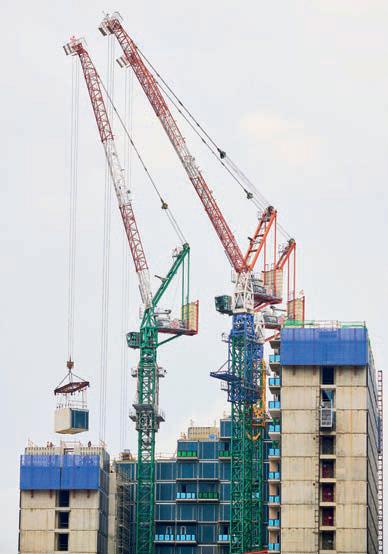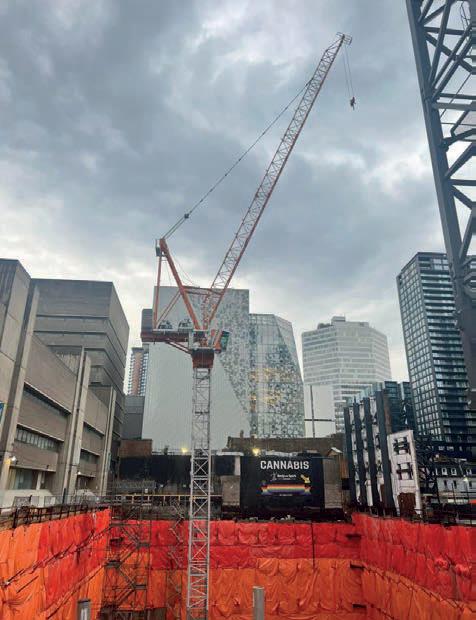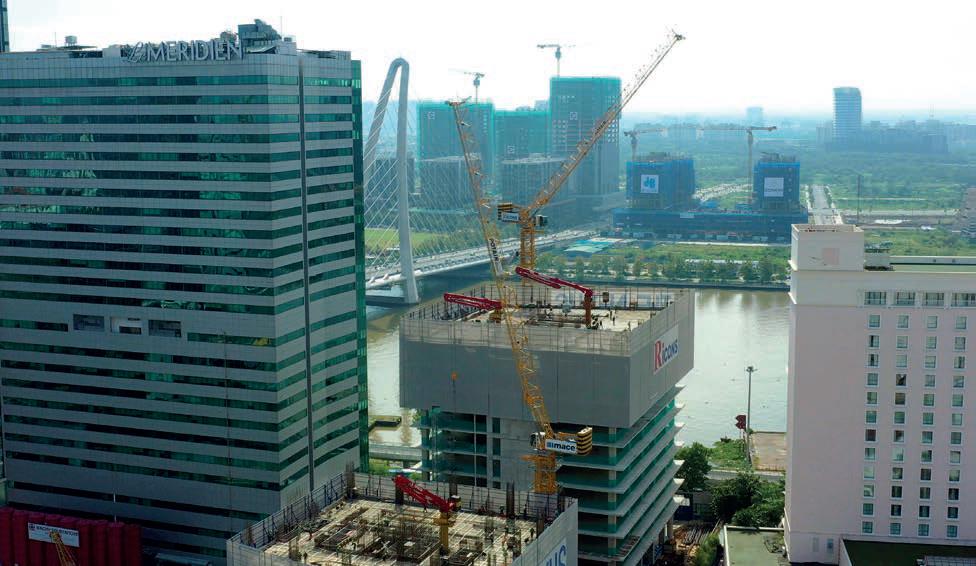A class above
19 June 2023The ability to reach great heights with little radii means luffing jib cranes are in demand in cities around the world. Will North reports.
Luffing jib tower cranes serve a particular purpose and are most common in specific markets: those like the UK, where building owners have the right to charge for oversailing their building; and others, like New York and Singapore, where growing clusters of skyscrapers demand the ability to work within a tight radius.
These are not, however, niche markets. Urbanisation has been the dominant trend of the postwar, post-colonial world.
In 1960, the UN reports, around a third of the world’s population lived in cities. By the millennium, that had reached 47%, and in the latest figures, for 2021, it stands at 56%. That’s more than half of the world’s 9bn or so people, all of whom will want to be close to a public transport hub and local shops, schools, and entertainment venues. Anyone who has stood on the banks of the Thames, in Central Park, or on Shanghai’s Bund, will know what that means: a forest of skyscrapers. And those skyscrapers will very often need luffers to build them.
The crane industry has These are not, however, niche markets. Urbanisation has been the dominant trend of the postwar, post-colonial world. In 1960, the UN reports, around a third of the world’s population lived in cities. By the millennium, that had reached 47%, and in the latest figures, for 2021, it stands at 56%. That’s more than half of the world’s 9bn or so people, all of whom will want to be close to a public transport hub and local shops, schools, and entertainment venues. Anyone who has stood on the banks of the Thames, in Central Park, or on Shanghai’s Bund, will know what that means: a forest of skyscrapers. And those skyscrapers will very often need luffers to build them. The crane industry has responded to this surging demand for the high life, with cranes that can reach great heights within tightly limited radii. The last year has seen a wealth of new models to suit every need. At Bauma Liebherr and Wolffkran, two of the leaders in the field, had luffers on display: Wolffkran had the 235B, launched in 2020, able to lift 4.1t on a 50m jib; and, as we saw in the fibre rope article in this section, Liebherr launched its first fibre rope luffer, the 258 HC-L 10/18 Fibre.
BENCHMARK LEVEL
The 700tm capacity class has become the benchmark for rope luffer manufacturers. It gives the power needed to pour at pace, particularly in tall buildings where concrete can set in the bucket before it reaches the working floor; and allows for large steel and concrete modules to be lifted and, when used with a second rope, manipulated with ease. If you want to build hundreds of metres into the air, over an awe-inspiring multi-storey atrium, it’s the class of crane you need.
Saez, in Spain, offers both hydraulic and rope luffers. While the hydraulics are great for very tight out-of-service radii, and can work close to buildings with minimal backswing, it is rope luffers that offer the real power.
And Saez’s R&D department has been working intently on competing at the highest level in the class. A 1450t/m class crane is on the drawing boards: if and when it is launched, it looks likely to rival some of the truly massive luffers, pioneered by the likes of Favelle Favco and the TG range, once built by Link-Belt. These are the sorts of cranes you use to build a nuclear power plant or a continentconnecting bridge, as Favelle Australia-based international hirers Marr has been doing in the UK and Turkey.
But these are rare and specialist jobs. With the Saez SL 730, the Murcian manufacturer hits a significant milestone, putting it in contention with world-leading rivals like Wolffkran and Liebherr. In its standard version, with a 123kW hoist motor, it can lift 36t. With the added power of an optional 140kW motor, it can raise as much as 50t.
The crane features a 70m jib, 5m more than that offered on Liebherr’s comparable model. With this lowered to its full extension, the crane can lift more than 6t. The crane features a high strength slewing mechanism, with the pivot point for the luffer centred above the mast, allowing it to keep its out-ofservice radius to below 20m.
The first unit of the new model has gone to Bennett’s in the UK, who also took the first two units in the country of Saez’s next biggest rope luffer, the SL 450.
The company, which emphasises its commitment to modular construction methods, put these to work in 2019-2020 in Birmingham, where customer Colmore Tang has been building a luxury apartment complex, connected to a Regis hotel. The project saw the two cranes working at freestanding heights of 40m and 60m, and being used to lift large pre-glazed concrete panels.
TAKING CONTROL
At Bauma, Manitowoc launched the first in a new generation of Potain rope luffers, the MR 229. This is the company’s first crane in the segment to feature its standardised CCS control system, which the company says will now be rolled out across the range as it is upgraded.
Standardised control systems like CCS promise to help ease operator training and familiarisation. It is already available across Potain’s hammerhead range, and on the company’s mobile cranes.
The latest luffer, with a 14t maximum capacity, is designed for ease of erection. The luffing mechanism has been redesigned, making assembly easier. A basket on the jib tip improves rigger safety, and the jib, luffing system and hoist have been redesigned for easier installation.
Along with the control offered by CCS, which, among other features, lets operators precisely controls movement speeds, the crane comes with Potain Connect, the company’s new telematics system.
Select orders four more Terex luffing jib tower cranes
UK-based Select Plant Hire has ordered four new Terex CTL1600 luffi ng jib tower cranes – bringing its fl eet total of CTL1600s to nine. Terex Tower Cranes says this makes it the largest and newest fl eet of these cranes in the world. According to Terex, its CTL1600 is a popular choice for construction and rental companies globally and is well-suited for high-rise buildings on urban job sites. With a maximum capacity of 66 t (72.8 USt) and jib length of 75 m (246 ft) it is the biggest luffi ng jib crane in its range. It is also equipped with features including T-Torque slewing technology, Terex Power Plus, and Terex Power Match. Terex Tower Cranes says, due to its heavy capacity, the CTL1600 is in high demand in the UK – especially for heavy lift requirements such as precast and other projects that incorporate offsite manufacturing and modern methods of construction, with Select Plant Hire identifying particular demand for using these cranes coming from the waste-to-energy and data centres being commissioned across the UK.
City snapshot: Tower cranes in Toronto
Toronto, Canada is a hot bed of construction at present. The image on the left shows Canadian construction company Verdi Alliance’s fi rst Moritsch Cranes’ RTL285B on a job site in the city, while the image on the right shows Canadian builder Avenue Building Corporation using Raimondi LR273 luffi ng cranes on the high profi le Nobu Residences in downtown Toronto. The company says it selected that model due to its out of service boom angle.
A WOLFF 355 B erected on a 3 m tower at the recent Vertikal Days trade show in the UK. Wolffkran’s WOLFF 355 B has been in production since 2007 and the company says it is still one of its most popular cranes.
Three Jaso J380PA luffing jib tower cranes are erecting the new Club Street Hotel in Singapore.
Vietnamese contractor Ricons is using two Potain MCH 175 hydraulic luffi ng jib cranes to construct a new offi ce complex, called The Nexus, in Ho Chi Minh City, Vietnam. It purchased one of the cranes for the project and rented the other, both from Potain distributor Minh Chi. The cranes have been working on The Nexus jobsite since September 2021.







